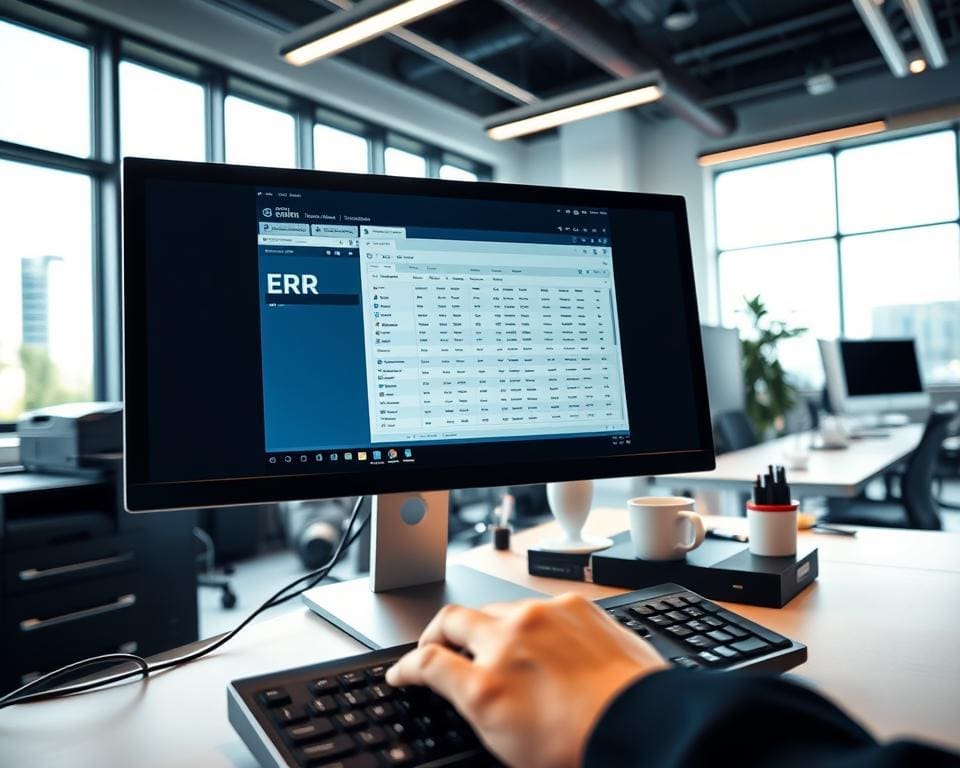In today’s fast-paced business environment, the efficiency of your processes often hinges on the strength of your ERP system. Is your ERP system due for a major upgrade? Understanding when to invest in an ERP system upgrade can be pivotal for maintaining a competitive edge. Outdated systems can limit growth, reduce adaptability, and adversely affect overall business effectiveness. This article aims to illuminate the importance of evaluating your current ERP software and recognising the signs that it’s time for an upgrade, empowering businesses to make informed decisions for their operational needs.
Understanding ERP Systems and Their Importance
Enterprise resource planning (ERP) systems are essential tools for modern businesses. They serve as comprehensive software solutions that integrate various core business processes, promoting efficiency and cohesion across departments. Organisations increasingly rely on ERP systems to automate and streamline operations, which ultimately enhances productivity and allows for better resource allocation.
What is an ERP System?
An ERP system is fundamentally designed to unify critical business functions into a single cohesive platform. This integration covers a wide range of areas, from supply chain management and inventory control to human resources and financial management. Effective ERP software maintenance is crucial to ensure these systems remain responsive to organisations’ evolving needs. Companies harness ERP system enhancements to keep pace with industry standards and technological advancements, thus maintaining a competitive edge.
The Role of ERP in Business Operations
ERP systems play a vital role in the operational landscape of businesses by improving data accuracy and streamlining workflows. Enhanced data visibility allows decision-makers to derive insights from real-time information, leading to informed strategic choices. The combination of improved efficiency and precise data contributes to accelerated project timelines and enhances overall productivity. Businesses that have successfully implemented ERP solutions showcase how these systems reinforce their organisational goals and drive growth.

Indicators That Your ERP System Needs an Upgrade
Recognising when your ERP system requires an upgrade can be pivotal for maintaining operational efficiency. Several clear indicators signal the need for ERP system updates, highlighting issues that may impede productivity and overall performance.
Performance Issues and Slowdowns
One of the most common signs that upgrading ERP software is necessary involves performance issues. Users may experience slow processing speeds and increased error rates consistently. These interruptions can disrupt workflows, leading to frustration and decreased morale among employees. Regular ERP software maintenance becomes inadequate when these performance challenges persist, necessitating a significant upgrade.
Incompatibility with Modern Technologies
An outdated ERP system often struggles to integrate with the latest technologies, such as cloud computing and advanced analytics tools. This incompatibility hampers a business’s ability to leverage modern solutions that enhance efficiency and decision-making. Upgrading your ERP software ensures that your organisation can stay relevant and competitive in an ever-evolving technological landscape.
Poor User Experience and Feedback
User experience plays a crucial role in the effectiveness of an ERP system. Negative feedback from employees regarding usability can highlight underlying issues that require attention. If staff members find the system cumbersome or unintuitive, productivity may suffer. Addressing these concerns through timely ERP system updates can greatly enhance both user satisfaction and operational efficiency.
Is your ERP system due for a major upgrade?
In today’s rapidly evolving business landscape, maintaining an efficient ERP system is crucial for competitiveness. A thorough assessment of your current system’s functionality can reveal whether an upgrade is warranted. By identifying existing capabilities and their alignment with current business needs, companies can strategically plan for improvements. This analysis lays the foundation for potential ERP system migration, ensuring that organisations are poised for future challenges.
Assessing Current Functionality
Evaluating the features of your existing ERP system involves pinpointing both strengths and weaknesses. Companies should consider:
- Integration capabilities with existing technologies
- User satisfaction and feedback from employees
- Fulfilment of core business processes
- Adaptability to changing market demands
These factors serve as benchmarks for assessing how well the current system supports operational needs. Upgrading ERP software can often enhance these functionalities, paving the way for effective ERP system optimization.
Evaluating Operational Improvements
Identifying areas for operational enhancements is essential for realising the full potential of your ERP system. Consider these key evaluation points:
- Streamlining workflows to reduce bottlenecks
- Enhancing data analysis capabilities for informed decision-making
- Facilitating better communication between departments
- Implementing automation for repetitive tasks
By actively seeking operational improvements, organisations can unlock significant benefits from their systems. An effective ERP system migration not only upgrades technological capacity but also augments overall productivity.
Benefits of Upgrading Your ERP Software
Investing in ERP system upgrades can transform business operations by offering a multitude of advantages. Upgrading ERP software not only enhances functionalities but optimises overall efficiency, ensuring that businesses remain competitive in a rapidly evolving market.
Enhanced Features and Functionality
One of the most significant benefits of upgrading an ERP system lies in the enhanced features it provides. Modernizing the ERP system can introduce advanced reporting tools, improved automation capabilities, and more intuitive user interfaces. These enhancements lead to more streamlined operations, allowing teams to focus on strategic tasks rather than getting bogged down by tedious processes.
Improved Integration Capabilities
Upgrading your ERP software facilitates better integration with various third-party applications, such as Customer Relationship Management (CRM) systems. This seamless connectivity fosters efficient data flow between platforms, effectively breaking down data silos. As a result, businesses can access comprehensive insights, making informed decisions to drive growth and enhance customer satisfaction.
ERP System Updates: What to Expect
Upgrading ERP software represents a significant opportunity for businesses to enhance operational efficiency and adapt to changing market demands. Understanding the types of upgrades available can set the stage for successful ERP system updates.
Types of ERP Upgrades Available
ERP upgrades generally fall into two categories: minor tweaks and major overhauls. Minor tweaks may include small adjustments to existing features or user interfaces, which help enhance the user experience without extensive disruption. Major overhauls often entail comprehensive system updates that introduce new functionality or integrate entirely new modules, allowing companies to stay competitive.
Cost Considerations for Upgrading
When planning for upgrading ERP software, it is essential to consider various cost factors. Businesses should evaluate licensing fees, implementation expenses, and the training costs associated with new features. Careful assessment of these financial implications provides a clearer picture of the potential return on investment. By understanding these cost considerations for upgrading, companies are better equipped to make informed decisions that align with their long-term goals.
Modernising Your ERP System
In today’s dynamic business environment, organisations face the challenge of keeping their ERP systems up to date. The integration of advanced technologies such as artificial intelligence and machine learning significantly enhances operational efficiencies, pushing organisations to modernise ERP system frameworks to remain competitive.
Latest Trends in ERP Technology
Many businesses are leveraging emerging trends to improve performance and drive innovation. Key advancements in ERP technology now include:
- Artificial intelligence for predictive analytics
- Machine learning capabilities for automated tasks
- Enhanced user interfaces for improved accessibility
These innovations facilitate easier ERP system migrations, allowing for a smoother transition to updated platforms while minimising operational disruptions. Organisations adopting these technologies often witness transformative changes in productivity and decision-making processes.
Cloud vs On-Premises Solutions
A critical aspect of modernising your ERP system involves choosing between cloud and on-premises solutions. Each option carries unique advantages and challenges that impact business operations:
- Cloud Solutions: These offer flexibility and scalability, making them ideal for businesses seeking to expand without the constraints of physical infrastructure.
- On-Premises Solutions: These provide enhanced control over data security and compliance but require substantial upfront investment and maintenance costs.
Organisations should evaluate their specific needs, weighing the benefits and drawbacks of cloud vs on-premises solutions to ensure alignment with their strategic objectives.
Planning Your ERP System Migration
Embarking on an ERP system migration is a significant step for any organisation seeking to enhance operational efficiency. A well-structured migration plan is essential to navigate the complexities of upgrading ERP software and ensuring a smooth transition. Begin by assessing your current system’s capability and aligning it with your future business goals. Identifying specific needs, such as improved data management and user functionality, can provide a clear direction for your migration journey.
Data security is paramount during the ERP system migration process. Implement robust protocols to safeguard sensitive information while transferring data to the new system. Additionally, consider investing in comprehensive user training and support systems, which can significantly reduce resistance to change and ensure that employees feel confident using the upgraded features. Having a proactive training strategy in place can enhance user adoption and improve overall productivity post-migration.
A thorough risk assessment is indispensable when planning your ERP software maintenance strategy. An in-depth analysis of potential challenges, ranging from integration issues to downtime, will enable your organisation to develop contingencies that minimise disruption. By addressing these risks head-on and equipping your team with the right tools and knowledge, you can transform your ERP migration into a strategic advantage, ultimately positioning your business for success in a rapidly evolving market landscape.









